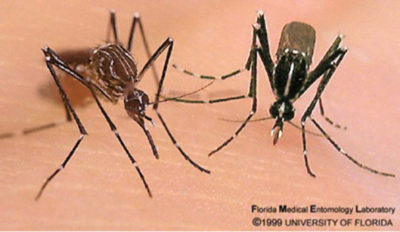 Dr. Roxanne Connelly received her PhD in Entomology from Louisiana State University, majoring in Medical Entomology with a minor in Epidemiology and Community Health. She works at the University of Florida, IFAS, Florida Medical Entomology Laboratory where she is a Professor and Extension Specialist in Medical Entomology. Responsibilities include maintaining close contact with over 50 mosquito control districts in the state of Florida to address their research and training needs; maintaining contact with the county extension faculty and the public at large by developing educational materials and participating in short courses on topics related to medical entomology. Her research includes biology and identification of mosquitoes, protection from mosquito‐borne diseases, and arthropod pest control methodology. She also mentors graduate students in medical entomology. She is a Past President of the American Mosquito Control Association and the Florida Mosquito Control Association, and is a Board Certified Entomologist of the Entomological Society of America.
Dr. Roxanne Connelly received her PhD in Entomology from Louisiana State University, majoring in Medical Entomology with a minor in Epidemiology and Community Health. She works at the University of Florida, IFAS, Florida Medical Entomology Laboratory where she is a Professor and Extension Specialist in Medical Entomology. Responsibilities include maintaining close contact with over 50 mosquito control districts in the state of Florida to address their research and training needs; maintaining contact with the county extension faculty and the public at large by developing educational materials and participating in short courses on topics related to medical entomology. Her research includes biology and identification of mosquitoes, protection from mosquito‐borne diseases, and arthropod pest control methodology. She also mentors graduate students in medical entomology. She is a Past President of the American Mosquito Control Association and the Florida Mosquito Control Association, and is a Board Certified Entomologist of the Entomological Society of America.
By Roxanne Connelly
UF/IFAS Extension Specialist, Professor of Medical Entomology
They are full-time residents of Florida, they live in every Florida county, they flourish in the warm water, they love heat and humidity, and many were here before any of the current Floridians arrived. They are mosquitoes, and they are the most dangerous animal on the planet.
Of the 80 mosquito species that occur in Florida, roughly a dozen are medically important vectors, the word for something that carries and transmits disease-bearing pathogens. One, possibly two, Florida mosquito species are capable of transmitting Zika virus to humans.

Figure 1. Aedes aegypti, the “yellow fever mosquito” (left); Aedes albopictus the “Asian tiger mosquito” (right).
News reports describing Zika virus exploded in early 2016. Overnight, people who may never have thought about mosquito-borne diseases became aware of Zika and its potential to cause devastating birth defects. The “yellow fever mosquito” (Aedes aegypti), is known to be the primary vector of Zika virus. The potential for a second mosquito species, “the Asian tiger mosquito” (Aedes albopictus) to be involved in transmission of the virus in Florida is uncertain but possible. Both of these mosquito species (Figure 1) occur in Florida and are commonly known as “domestic” or “container” mosquitoes due to where they begin their life cycle, close to human habitation. Historically, the “yellow fever mosquito” occurred in all Florida counties, but in the 1980s and 1990s, there was a decline of this species in north and central Florida. Recent surveys for this species indicate that it does occur in south and central Florida. Research is ongoing to develop an updated distribution map of this species in Florida.
Zika virus has made its way into local “yellow fever mosquito” populations in Miami. While cases will continue to be identified from travelers who have been to countries where Zika transmission is ongoing, local transmission from Florida mosquitoes is isolated to a small area at this time. What does this mean for Floridians? Some perspective and evidence-based information are provided here to answer that question.
In order for a mosquito-borne disease such as Zika to become epidemic and to be sustained long term, it requires an abundance of the specific mosquito vector, infected humans that are fed upon by the specific mosquito vector while the virus is circulating in their blood, uninfected humans, and various physical and environmental conditions including densely populated residential areas, homes where windows with no screens remain open, homes where screen-less doors remain open, and areas with an abundance of water-holding sites that the “yellow fever mosquito” prefers, such as buckets, tires, bromeliad plants, toys, and pet dishes. Additionally, as doors and windows stay open, allowing the mosquitoes unencumbered entry, the “yellow fever mosquito” can become established inside the home in flower vases, refrigerator drip pans, mop buckets that are holding water, and others similar items. Under these conditions, the mosquito never has to leave the house to keep the mosquito life cycle going. Consider your own surroundings and read on.
Many people have come to believe that mosquito control is the exclusive responsibility of county and state agencies. Meeting the threat posed by container mosquitoes requires action by everyone. This is challenging. These mosquitoes begin their lives in literally millions of small, cryptic habitats in every Florida neighborhood. It is our responsibility as homeowners, parents, and citizens to guard against container mosquitoes. The approach for reducing container mosquitoes requires diligent and thorough removal of, or modification to, containers that can hold water including pet water bowls, plant holding saucers, boat tarps, trash, tires, bromeliad plants, corrugated downspout extensions, clogged roof gutters, and more; flushing and replacing water in containers that are not disposable (birdbaths and bromeliads for example), scrubbing the inside walls of birdbaths and other items to remove mosquito eggs; involving neighbors and entire communities in conducting these techniques; and wearing effective repellents. These techniques work!
There are many devices on the market advertised to control “Zika mosquitoes.” How do you know if they will work? Unfortunately, many of these products and services take advantage of the concerns we have to protect family members from mosquito-borne disease. Be aware of advertising that is intended to elicit responses by using fear tactics. Pay attention to press releases from your county health departments and mosquito control agencies; they are conducting surveillance and testing for the virus throughout the state and will provide information to residents if there are any concerns locally. Trinkets, bracelets, and other gizmos that are advertised to scare away mosquitoes or create an invisibility shield around a person do not work and do not provide protection from mosquito bites. And keep in mind that mosquito traps are never as attractive to the mosquito as a living, breathing, warm-bodied human! Traps may collect mosquitoes, but they don’t provide individual protection from mosquito bites.
Protecting public health depends on each of us taking responsibility for removing the threat of container mosquitoes. You and your neighbor and the entire community must be involved. We are “our brother and sister’s keeper.”
Remember to:
- Dump and Drain
- Dress Appropriately
- Defend (use repellents)
- Don’t Panic
The University of Florida, Florida Medical Entomology Laboratory, IFAS Extension, Florida Department of Health, Florida Department of Agriculture and Consumer Services, Florida Mosquito Control Association, and Florida mosquito control agencies are working together to communicate with the public, to provide information on reducing container mosquitoes and selecting proper repellents, and to encourage community-wide campaigns to rid areas of container mosquitoes. Fact sheets have been developed to assist with these communication efforts:
Florida Container Mosquitos EDIS Doc Mosquito Information Website Extension Disaster Education Network – Zika Disease Mosquito Repellants EDIS Doc

















